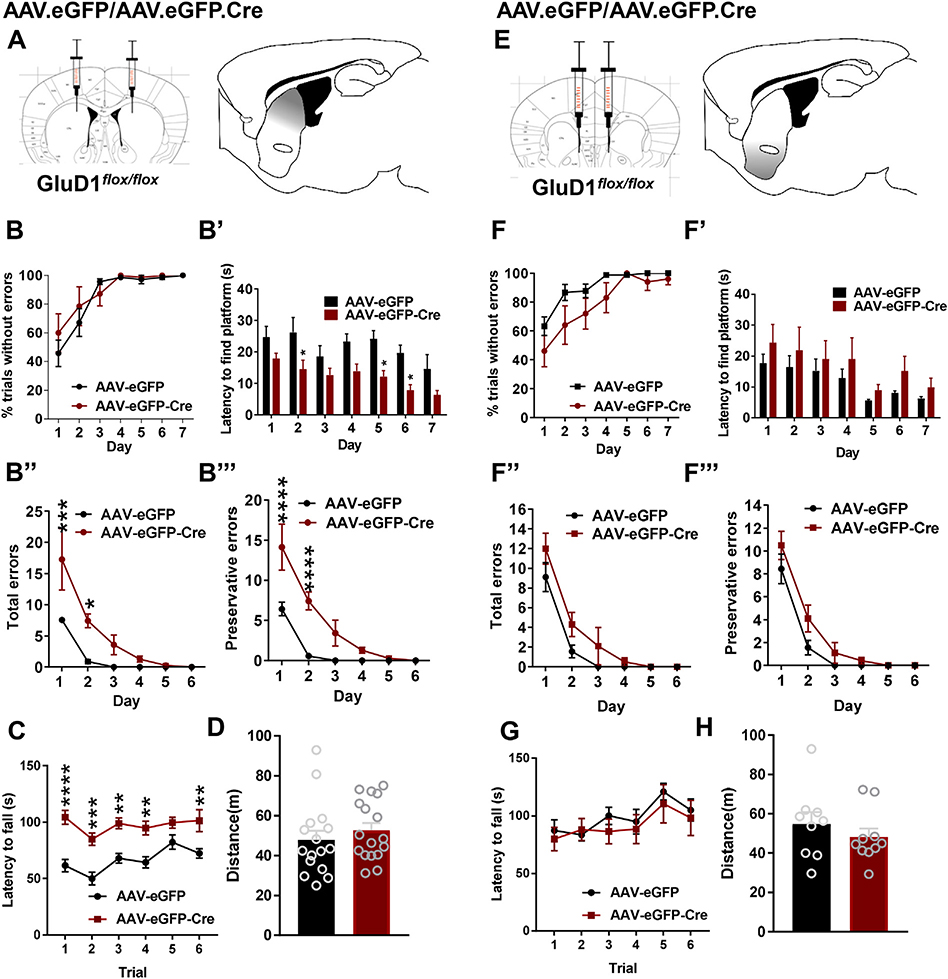Fig. 2.
GluD1 in the dorsal striatum controls behavioral flexibility. A. Strategy for local ablation of GluD1 from dorsal striatum. AAV-eGFP or AAV-eGFP-Cre were stereotaxically injected into the dorsal striatum of GluD1flox/flox mice. B. Striatal AAV-eGFP and AAV-eGFP-Cre mice did not show any significant change in the percent trials without errors on training days (N = 7 for AAV-eGFP and 7 for AAV-eGFP-Cre). B′. The latency to reach the platform during the training (habit acquisition) phase was shorter in AAV-eGFP-Cre compared to the AAV-eGFP group. Two-way repeated measures ANOVA treatment [F (1, 12) = 13.95, p = .0029)], days [F (6, 72) = 5.064, p < .0002)] and interaction [F (6, 72) = 0.5384, p = .7773. Post-hoc Bonferroni’s test revealed significance at day 2: AAV-eGFP 32.24 ± 4.718 vs. AAV-eGFP-Cre 14.53 ± 2.878, p = .0343; day 5: AAV-eGFP 24.16 ± 2.635, vs. AAV-eGFP-Cre 12.16 ± 1.96, p = .0279; day 6: AAV-eGFP 19.64 ± 2.532, vs AAV-eGFP-Cre 7.814 ± 1.729, p = .0316. B″. During reversal learning test, AAV-eGFP-Cre mice made significantly more total errors compared to AAV-eGFP group. Two-way repeated measures ANOVA treatment [F (1, 12) = 19.05, p = .0009)], days [F (5, 60) = 18.49, p < .0001)] and interaction [F (5, 60) = 3.057, p = .0160]. Bonferroni’s post-hoc test revealed significance on day 1 (AAV-eGFP 7.571 ± 0.4809 vs. AAV-eGFP-Cre 17.29 ± 4.932, p < .0002); day 2 (AAV-eGFP 0.8571 ± 0.3401 vs. AAV-eGFP-Cre 7.429 ± 1.11, p < .0220). B″’. Similarly, AAV-eGFP-Cre committed more number of perseverative errors compared to AAV-eGFP group. Two-way repeated measures ANOVA treatment [F (1, 12) = 31.69, p = .0001)], days [F (5, 60) = 28.2, p < .0001)] and interaction [F (5, 60) = 5.064, p = .0006]. Bonferroni’s post-hoc test revealed significance on day 1 (AAV-eGFP 6.429 ± 0.8411 vs AAV-eGFP-Cre 14.14 ± 2.874, p < .0001); day 2 (AAV-eGFP 0.5714 ± 0.2974 vs AAV-eGFP-Cre 7.429 ± 1.11, p < .0001). C. In the rotarod test, the latency to fall during test phase was longer in AAV-eGFP-Cre than AAV-eGFP injected mice (N = 14 for AAV-eGFP and N = 13 for AAV-eGFP-Cre). Two-way repeated measures ANOVA revealed a significant effect of genotype [F (1, 25) = 37.4, p < .0001], trials [F (5, 125) = 5.19, p = .0002] and interaction [F (5, 125) = 1.38, p = .2360] on falling latency. Bonferroni’s post-hoc test revealed a significant difference in falling latency of AAV-eGFP-Cre mice (trial 1 AAV-eGFP 61.52 ± 5.466 vs AAV-eGFP-Cre 104.3 ± 6.22: p < .0001; trial 2 AAV-eGFP 49.94 ± 5.615 vs AAV-eGFP-Cre 84.82 ± 5.487: p < .0002; trial 3 AAV-eGFP 67.91 ± 4.34 vs AAV-eGFP-Cre 98.85 ± 4.789: p < .0014; trial 4 AAV-eGFP 64.35 ± 4.988 vs AAV-eGFP-Cre 94.72 ± 5.995: p < .0018; trial 6 AAV-eGFP 72.28 ± 4.11 vs AAV-eGFP-Cre 101.3 ± 9.748: p < .0032). D. In the open field test, no significant difference was found between AAV-eGFP and AAV-eGFP-Cre injected mice in total distance traveled (N = 16 for AAV-eGFP and N = 17 AAV-eGFP-Cre; AAV-eGFP 47.88 ± 4.587 vs AAV-eGFP-Cre 52.78 ± 3.614, p = .4080, unpaired t-test). E. Strategy of deletion of GluD1 from ventral striatum. AAV-eGFP or AAV-eGFP-Cre vectors were setereotaxically injected into the ventral striatum of GluD1flox/flox mice. F. During the habit acquisition no significant difference was observed between AAV-eGFP and AAV-eGFP-Cre mice, (treatment [F (1, 17) = 2.466, p = .1347, Two-way repeated measures ANOVA) (N = 9 for AAV-eGFP and 10 for AAV-eGFP-Cre). F′. No significant differences were observed in the latency to find the platform, although a trend for higher latency was observed on day 2 (treatment [F (1, 17) = 0.9066, p = .03544)]). F″-F″’. No significant differences were observed in total errors (treatment [F (1, 17) = 4.523, p = .0484]) or preservative errors (treatment [F (1, 17) = 4.055, p = .0601]) during the reversal learning in corticolimbic-GluD1 KO. G. In the rotarod test, during test phase no significant difference in the latency to fall was observed in AAV-eGFP and AAV-eGFP-Cre injected mice (N = 9 for AAV-eGFP and N = 9 for AAV-eGFP-Cre; Two way repeated measures ANOVA genotype [F (1, 16) = 0.3285, p = .5745], trials [F (5, 80) = 4.826, p = .0007] and interaction [F (5, 80) = 0.3245, p = .8968]). H. In the open field test, no significant difference was found between AAV-eGFP and AAV-eGFP-Cre injected mice in total distance traveled (N = 9 for AAV-eGFP and N = 10 AAV-eGFP-Cre; AAV-eGFP 54.76 ± 6.085 vs AAV-eGFP-Cre 48.2 ± 4.254, p = .3917, unpaired t-test). All data are presented as mean ± SEM.

